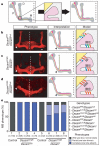Dscam diversity is essential for neuronal wiring and self-recognition
- PMID: 17851526
- PMCID: PMC2691715
- DOI: 10.1038/nature06099
Dscam diversity is essential for neuronal wiring and self-recognition
Abstract
Neurons are thought to use diverse families of cell-surface molecules for cell recognition during circuit assembly. In Drosophila, alternative splicing of the Down syndrome cell adhesion molecule (Dscam) gene potentially generates 38,016 closely related transmembrane proteins of the immunoglobulin superfamily, each comprising one of 19,008 alternative ectodomains linked to one of two alternative transmembrane segments. These ectodomains show isoform-specific homophilic binding, leading to speculation that Dscam proteins mediate cell recognition. Genetic studies have established that Dscam is required for neural circuit assembly, but the extent to which isoform diversity contributes to this process is not known. Here we provide conclusive evidence that Dscam diversity is essential for circuit assembly. Using homologous recombination, we reduced the entire repertoire of Dscam ectodomains to just a single isoform. Neural circuits in these mutants are severely disorganized. Furthermore, we show that it is crucial for neighbouring neurons to express distinct isoforms, but that the specific identity of the isoforms expressed in an individual neuron is unimportant. We conclude that Dscam diversity provides each neuron with a unique identity by which it can distinguish its own processes from those of other neurons, and that this self-recognition is essential for wiring the Drosophila brain.
Figures




References
-
- Schmucker D, et al. Drosophila Dscam is an axon guidance receptor exhibiting extraordinary molecular diversity. Cell. 2000;101:671–684. - PubMed
-
- Wang J, Zugates CT, Liang IH, Lee CH, Lee T. Drosophila Dscam is required for divergent segregation of sister branches and suppresses ectopic bifurcation of axons. Neuron. 2002;33:559–571. - PubMed
-
- Zhu H, et al. Dendritic patterning by Dscam and synaptic partner matching in the Drosophila antennal lobe. Nature Neurosci. 2006;9:349–355. - PubMed
-
- Chen BE, et al. The molecular diversity of Dscam is functionally required for neuronal wiring specificity in Drosophila. Cell. 2006;125:607–620. - PubMed
Publication types
MeSH terms
Substances
Grants and funding
LinkOut - more resources
Full Text Sources
Other Literature Sources
Molecular Biology Databases

